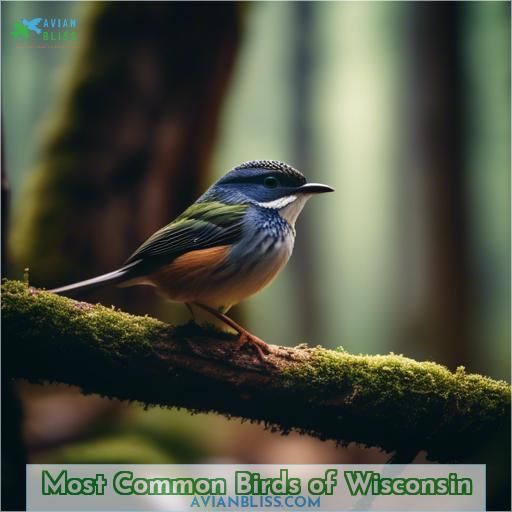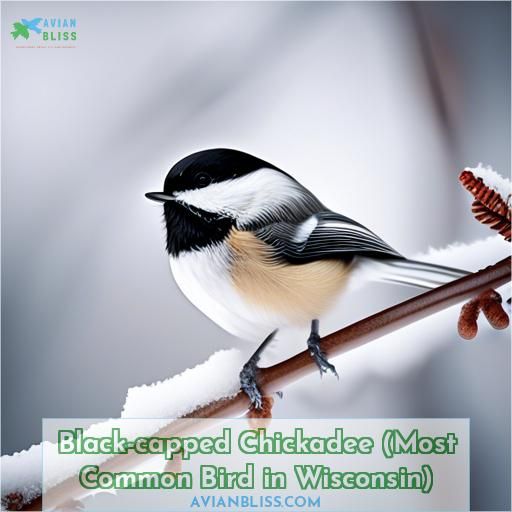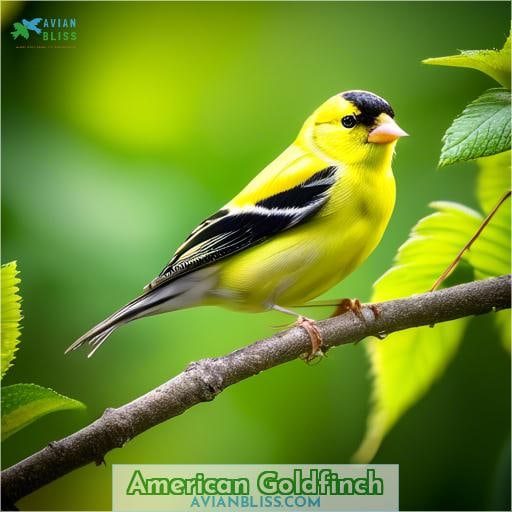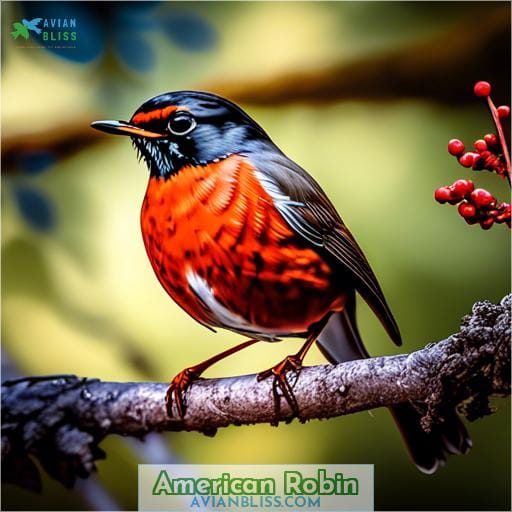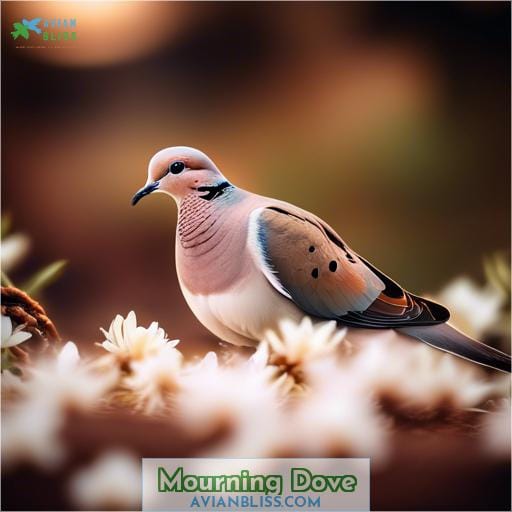This site is supported by our readers. We may earn a commission, at no cost to you, if you purchase through links.
 Immerse yourself in Wisconsin’s avian wonders!
Immerse yourself in Wisconsin’s avian wonders!
Discover common backyard birds like the cheerful black-capped chickadee, vibrant northern cardinal, and melodious American robin.
With diverse habitats spanning forests, prairies, and waterways, Wisconsin offers an array of feathered friends awaiting your watchful eye.
Become an avid birder by identifying and appreciating these remarkable winged creatures thriving in your local environment.
Table Of Contents
- Key Takeaways
- Most Common Birds of Wisconsin
- Black-capped Chickadee (Most Common Bird in Wisconsin)
- American Crow
- Northern Cardinal
- American Goldfinch
- Blue Jay
- American Robin
- Mourning Dove
- Downy Woodpecker
- White-breasted Nuthatch
- Frequently Asked Questions (FAQs)
- What are the most common birds in Wisconsin?
- What are the habitats of the most common birds in Wisconsin?
- What are the dietary preferences of the most common birds in Wisconsin?
- How do the most common birds in Wisconsin communicate with each other?
- What are the reproductive habits of the most common birds in Wisconsin?
- Conclusion
Key Takeaways
- Wisconsin is home to a diverse array of common birds, including the Black-capped Chickadee, American Crow, Northern Cardinal, American Goldfinch, Blue Jay, and American Robin.
- These birds inhabit various habitats, from forests and prairies to waterways and suburban areas.
- Each bird species has unique characteristics, vocalizations, and dietary preferences, contributing to the richness of Wisconsin’s avian wonders.
- Observing and identifying these common birds can foster a deeper connection to the natural environment and promote appreciation for the diverse ecosystems in Wisconsin.
Most Common Birds of Wisconsin
Welcome to the world of Wisconsin’s most common birds! These feathered friends aren’t only a delight to spot in your backyard but also a testament to the diverse ecosystems that the Badger State has to offer. From the melodic tunes of the Black-capped Chickadee to the striking presence of the American Crow, these birds add a touch of charm to the Wisconsin landscape.
The Black-capped Chickadee, Wisconsin’s most common bird, is a small, grayish bird with a black cap and white face. Known for its distinctive chick-a-dee-dee-dee song, this bird is a year-round resident and can be found in various habitats, including forests, parks, and suburban areas.
The American Crow, with its all-black plumage and strong bill, is another common sight in Wisconsin. These intelligent birds are often seen in flocks and can be found in a variety of habitats, from forests to farmlands.
The Northern Cardinal, with its bright red males and grayish-brown females, is a popular bird in Wisconsin. These birds are known for their perky crests and bouncy flight patterns, making them a favorite among birdwatchers.
The American Goldfinch, with its vivid yellow plumage in summer and dull yellow with black streaks in winter, is another common bird in Wisconsin. These birds are attracted to thistle, aster, and sunflower plants and can often be found in overgrown areas and suburban gardens.
The Blue Jay, with its distinctive crest and blue upperparts, is another common sight in Wisconsin. These birds are known for their loud, jay, jay calls and can often be found in wooded areas and suburban neighborhoods.
These are just a few of the many common birds you can spot in Wisconsin. So, whether you’re a seasoned birdwatcher or just starting out, there’s always something new to discover in the Badger State. Happy birding!
Black-capped Chickadee (Most Common Bird in Wisconsin)
The Black-capped Chickadee is the most common bird in Wisconsin, and it’s not hard to see why. These small, grayish birds with black caps and white faces are a delight to spot in your backyard. During the winter months, they forage for insects, spiders, seeds, and fruit, making them a valuable addition to any ecosystem.
Black-capped Chickadees are known for their vocalizations, which include a whistled song and a distinctive chick-a-dee-dee-dee call. They’re also social birds, often interacting with other species in their habitat. Their social behavior makes them a favorite among birdwatchers, who enjoy observing their interspecies interactions.
When it comes to nesting, Black-capped Chickadees are meticulous. They prefer nesting in tree cavities and nest boxes, which they navigate with ease. Their nests are designed to enhance their survival, with a focus on providing a safe and secure environment for their young.
In the realm of common birds in Wisconsin, the Black-capped Chickadee stands out as a bird that isn’t only common but also a beloved friend to many. It’s not merely a bird; it’s a creature that adds beauty and life to our backyards.
American Crow
As you wander through Wisconsin’s landscapes, keep an ear out for the American crow’s distinctive call—a sure sign you’re in the company of one of the most intelligent birds around.
These all-black avians aren’t just about their striking looks; their vocalizations and brainpower set them apart.
Whether they’re solving puzzles or mimicking sounds, crows have a knack for impressing.
Their diet is as varied as their skills, feasting on anything from insects to leftovers, showcasing their adaptability.
Found across a wide range, these birds make themselves at home in both rural and urban settings, proving that when it comes to versatility, the American crow is unmatched.
So next time you hear that familiar caw, remember, you’re witnessing avian brilliance in action.
Northern Cardinal
As you navigate the complexities of birdwatching in Wisconsin, you’ll come across a vibrant, feathery friend: the Northern Cardinal. Known for their bright red plumage, these birds are a sight to behold. They’re not only seeking more than just a meal; they’re also on the hunt for a mate. During mating season, males display their colors and sing sharp chip notes to attract females. Once paired, they’ll work together to build a cup nest in trees, their home for the season.
The Northern Cardinal’s diet is as diverse as their mating habits. They feed on insects, seeds, berries, and fruit, ensuring they’re getting a balanced diet. As their habitat expands, they’re often found in parks, woodlands, and even towns. But don’t be fooled by their seemingly simple existence. The Northern Cardinal is a robust species, adapting to the ever-evolving world of birdwatching.
In the realm of backyard birds, the Northern Cardinal stands out. They’re not only companions to the American Robin, White-breasted Nuthatch, and Song Sparrow, but also the House Finch, their potential competitor for nesting sites. So, keep an eye out for these colorful creatures as you explore the birdwatching scene in Wisconsin.
American Goldfinch
American Goldfinches are a delightful sight in Wisconsin, especially during their breeding season. These birds are known for their vibrant yellow plumage and distinctive flight pattern. They aren’t only found in open fields and meadows but also in suburban areas, parks, and backyards. The American Goldfinch is unique among songbirds as it’s one of the last to breed each summer, often waiting until late August or even early fall to lay its eggs.
Their nesting season is short and begins to peak in late August. These nests are built in meadows, fields with tall grass, and shrubby areas. The nesting material is carefully constructed among twigs and is often three inches in width and no more than three inches in height. The female weaves the nest so securely that it’s watertight, which can pose a danger during heavy rainstorms.
American Goldfinches are strict vegetarians, selecting an entirely vegetable diet, and only inadvertently swallowing an occasional insect. They wait to nest until June or July when milkweed, thistle, and other plants have produced their fibrous seeds, which goldfinches incorporate into their nests and also feed their young.
Their flight pattern is bouncy, and they frequently make their po-ta-to-chip calls. During the breeding season, these finches expand their territory as far as mid-Alberta. Those that breed in the northern regions migrate southward during the winter, while those in the lower 48 states remain permanent residents.
In winter, American Goldfinches form flocks and feed together with little aggression towards each other. The males look more like the females during winter. To help these birds, consider providing a Heated Birdbath in Winter.
These birds aren’t only visually appealing but also contribute to the ecosystem by consuming seeds from plants like thistle, aster, and sunflower, which are essential for their survival.
Blue Jay
Looking for a bird with a striking blue crest and a loud, distinctive call? Look no further than the Blue Jay! These birds are known for their intelligence and social behavior, making them a favorite among birdwatchers. Here’s what you need to know about these fascinating creatures:
Blue Jay Nesting: Blue Jays build their nests in the V of trees, using grass, small twigs, leaves, and bark. The female lays 3-6 eggs, which she incubates for up to 18 days. Both parents share in feeding the young birds, which fledge in about three weeks and leave the nesting area in about two months.
Blue Jay Calls: Blue Jays have a variety of calls, including the jeer sound used as a contact or flocking call, and the pump handle call, which involves bobbing up and down. They also make a variety of other calls, including an imitation of the scream of a Red-tailed Hawk.
Blue Jay Diet: These birds are omnivorous, with a diet that includes vegetable matter like acorns, beechnuts, and other nuts, as well as seeds, grain, berries, small fruits, and many insects, such as caterpillars, beetles, grasshoppers, and others.
Blue Jay Habitat: Blue Jays are found in a variety of habitats, including deciduous and mixed woods, suburban gardens, groves, towns, and even city parks. They favor areas with many oak or beech trees.
Blue Jay Behavior: Blue Jays are known for their intelligence and social behavior. They form tight social bonds and can recognize other birds of their species by the variable black markings on their heads and throats. They communicate with other blue jays using body language and vocalizations, including a crest that indicates aggression level.
So, next time you hear a loud, piercing call in your backyard, it might just be a Blue Jay! These birds are sure to add some color and excitement to your birdwatching experience.
American Robin
Spring migration is a thrilling time for bird enthusiasts in Wisconsin, and one of the most common birds to spot is the American Robin. This rusty-red-breasted bird is a familiar sight in various habitats, from parks to woodlands and even suburban areas. During winter, American Robins forage for berries, making them a valuable addition to backyard bird feeders.
As spring approaches, American Robins begin nesting behaviors, often in trees or shrubs. Juvenile robins are born helpless and rely on their parents for food and protection. They learn to fly and forage for insects, seeds, and berries, which underpins their survival in the ever-evolving world of nature.
American Robins aren’t only sought after for their vibrant colors but also for their unique vocalizations, which can be heard in the early morning and late afternoon. They’re a delightful sight, especially when perched on a branch, tail-flicking and hopping around.
In addition to American Robins, other common birds in Wisconsin include the Downy Woodpecker, Mourning Dove, Northern Flicker, and Common Yellowthroat. Each of these birds adds a distinct charm to the Wisconsin landscape, making it a haven for birdwatchers and nature lovers alike.
Mourning Dove
Mourning Doves are common visitors to Wisconsin backyards, especially during migration season. These birds are known for their sad and owl-like hooOOA, hoo, hoo, hoo calls, which can be heard from a distance. Mourning Doves are easily identified by their plump bodies, slender tails, and distinctive black spots on their wings. They’re often seen perched on wires or hopping along the ground, foraging for seeds and insects.
Mourning Doves are cavity nesters, which means they rely on natural cavities in trees or man-made nesting structures like birdhouses. They typically lay two eggs per clutch and can have multiple broods throughout the summer. Their nests are made of twigs, grasses, and feathers, and they’re known to reuse old nests or even nest in abandoned woodpecker holes.
Mourning Doves are attracted to bird feeders stocked with sunflower seeds, cracked corn, and millet. They’re also known to feed on mallard and red-winged blackbird eggs and nestlings, which can be a concern for birders who want to protect these species. House Wrens are a common predator of Mourning Dove eggs and nestlings, so providing nesting boxes for these birds can help protect Mourning Dove populations.
In summary, Mourning Doves are a common sight in Wisconsin backyards, and understanding their habits and needs can help birders provide them with the best possible care.
Downy Woodpecker
As you venture into the world of backyard birdwatching, the Downy Woodpecker is a delightful and common sight. This small, black-and-white bird with a red patch on the nape of its neck (males) is a frequent visitor to backyard feeding stations, where it feeds on insects, berries, and seeds.
In terms of habitat, Downy Woodpeckers can be found in open woodlands, orchards, parks, and backyards. They prefer deciduous trees and are often seen in city parks. During the breeding season, they excavate their nest cavities in dead wood, typically 5-50 feet above the ground.
Downy Woodpeckers are known for their distinctive drumming, which is used to announce territory and attract mates during the breeding season. They also have a variety of calls, including a tick, tchick, tcherrick, and a sharp whinnying call during the nesting season.
Downy Woodpeckers aren’t known to mate for life, but they do form pair bonds that can last for several seasons. They may re-pair in late winter if food sources are scarce, but data on the number of birds that do so isn’t available.
In terms of diet, Downy Woodpeckers feed on insects, particularly wood-boring larvae, caterpillars, and ants. They also consume berries and seeds such as poison ivy, sumac, and acorns. To attract these birds to your bird feeding station, you can provide suet or peanut butter-cornmeal mixtures.
Overall, the Downy Woodpecker is a fascinating and engaging bird to observe in your backyard. By providing the right food and habitat, you can attract these woodpeckers and enjoy watching their courtship displays, nesting habits, and parenting behaviors.
White-breasted Nuthatch
As you navigate the complexities of the realm of birds, you’ll find the white-breasted nuthatch to be a fascinating find. This bird is a small, agile creature with frosty white underparts and gray-blue backs, chestnut brown under tail and lower belly, and a black cap and neck. It’s not merely a pretty sight; it’s designed to enhance your understanding of the bird world.
The white-breasted nuthatch is a year-round resident in the heart of Wisconsin, and it’s not just an ordinary bird. It primarily consumes insects, making it a vital part of the ecosystem. You might spot this bird in mature woods, primarily consuming insects. It’s a common sight, just like the bald eagle or the red-bellied woodpecker, but it’s not just about the numbers. It’s about the experience.
If you’re seeking more than just a casual encounter, the white-breasted nuthatch is worth your time. It’s not just about the black cap or the chestnut belly; it’s about the experience of watching it navigate your backyard. It’s a bespoke, tailored experience that underpins the ever-evolving world of birds. So, next time you’re in the realm of birds, don’t forget to look out for the white-breasted nuthatch. It’s a feathered friend that’s worth your time.
Frequently Asked Questions (FAQs)
What are the most common birds in Wisconsin?
You’ll find Black-capped Chickadees, American Crows, Northern Cardinals, and American Goldfinches galore in the Badger State.
What are the habitats of the most common birds in Wisconsin?
You’ll find chickadees nesting in tree cavities, robins in yards and parks, and waterfowl like Canada geese near lakes and ponds.
What are the dietary preferences of the most common birds in Wisconsin?
Hey, forget the bland seed feeders – our feathered friends crave a gourmet buffet! Chickadees snack on insects and spiders, while goldfinches opt for thistle and sunflower seeds.
How do the most common birds in Wisconsin communicate with each other?
You’ll hear a cacophony of delightful chirps, tweets, and warbles as birds communicate through vocalizations. From the chickadee’s melodic whistles to the cardinal’s sharp chips, each species has its unique voice in nature’s symphony.
What are the reproductive habits of the most common birds in Wisconsin?
You’ll find many birds nesting in cavities, shrubs, or making cup-shaped nests in trees. Some lay 2-7 eggs, while others may have larger broods. Their reproductive behaviors ensure survival in Wisconsin’s diverse habitats.
Conclusion
Unveiling Wisconsin’s common birds invites you to appreciate nature’s symphony. Have you spotted vibrant cardinals or acrobatic chickadees darting through your backyard? Immerse yourself in their world by identifying these feathered friends.
Their presence enhances your local environment; observing them fosters a deeper connection to your surroundings.

